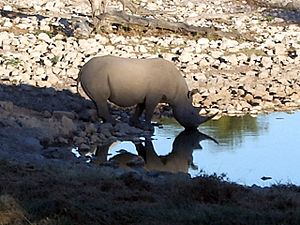Poaching facts for kids
Poaching means hunting, killing, or catching animals illegally. People poach animals to sell their body parts, like hides, ivory, horns, or bones. These parts are then used to make things like clothes or jewelry. Poaching can cause big problems for animal populations. The biggest problem is that it can lead to extinction, which means a whole type of animal disappears forever.
For example, poachers catch Indian tigers using steel traps. This is against the law. After catching a tiger, they kill it and sell its body parts for money. Just like the rhino, tigers are an endangered species. This means there are very few left in the wild. If poaching doesn't stop, both tigers and rhinos could become extinct. This would mean there would be no Indian tigers or rhinos left on Earth.
Why Poaching is a Problem
Poaching has many harmful effects on animals and their environments. Here are some of the main problems it causes:
- Less Wildlife in Forests: When animals like predators, plant-eaters, and fruit-eating animals are removed too quickly from a forest, their populations can't grow back. This changes how seeds are spread, and some plant species might disappear from that area.
- Fewer Animals and Extinction: Poaching directly reduces the number of animals in the wild. If it continues, it can lead to a species becoming extinct.
- Smaller Protected Areas: Poachers often use the edges of protected areas like national parks. This makes these safe zones less effective for animals.
- Harm to Tourism: Places that rely on wildlife tourism can suffer. When animals are poached, fewer tourists visit. This means less money for local businesses and fewer jobs for people who work in tourism.
- Spreading Diseases: Poaching can also lead to diseases spreading from animals to humans. This happens when people come into close contact with wild animals, especially when handling or eating their meat.
Why Animals Are Poached
People poach animals mainly for their body parts. In some cultures, people traditionally believe that parts of animals like tigers and rhinoceroses have special powers. They might think these parts can make people stronger or even cure diseases like cancer. These animal parts are sold illegally on the black market, especially in some Asian countries like Vietnam and China. However, there is no scientific proof that these animal parts actually work as medicine.
Some traditional medicines use ingredients from plants, animals, and minerals. Sadly, this has led to the use of parts from endangered species. These include seahorses, rhino horns, pangolin scales, and tiger bones. This demand creates a big illegal market for poachers. Even though laws protect critically endangered animals like the Sumatran tiger, their parts are still sold openly in some markets.
Rhino populations are in danger because of the demand for their horns. People in Asia use them for traditional medicine and as a luxury item. In the Middle East, horns are used for decoration. In 2012, one kilogram of crushed rhino horn could sell for as much as $60,000, which was more expensive than gold!
Ivory is another natural material that poachers seek. It comes from the tusks of animals like elephants. Ivory is used to create art objects and jewelry with beautiful carvings. China is a major buyer of illegal ivory. In 2012, reports showed that about 70% of all illegal ivory went to China.
Fur is also a material that poachers want. For example, a "Gamsbart" is a tuft of hair traditionally worn on hats in the Alps. It used to be made from the hair of the chamois' lower neck and was a hunting trophy.
Images for kids
-
Lady Baltimore, a bald eagle in Alaska survived a poaching attempt in the Juneau Raptor Center mews on 15 August 2015
See also
 In Spanish: Caza furtiva para niños
In Spanish: Caza furtiva para niños









